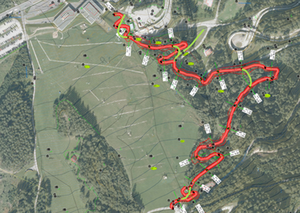A premiere at the 2027 Luge World Championships in Innsbruck/Igls (AUT): for the first time, the championships will be held together on the artificial track and in alpine luge. For the alpine luge event, the old 1964 Olympic track is being brought back from decades of disuse.

A first sketch of the new luge track in Igls
Innsbruck/Igls (FIL/23.09.2025) – At the 1964 Winter Olympics in Innsbruck, artificial track luge was in the Olympic program for the first time, and at the 1976 Winter Olympics, luge competitions were held on the artificial ice tube for the first time. Over the past 50 years, nature has reclaimed the old “Heiligwasser” luge track. For the 2027 alpine luge championships in Innsbruck/Igls, sections of this historic track will be restored. We spoke with Gerald Kammerlander, Sports Director for Alpine Luge at the Austrian Luge Federation (ÖRV), about this ambitious project.
FIL: How did the idea of a joint World Championships for artificial track and alpine luge come about?
Gerald Kammerlander: “The idea originated with ÖRV President Markus Prock, who suggested more than a year ago that Igls would be ideal for a combined World Championships. The last artificial track World Championships in Igls were in 2017, so 2027 is a perfect date for one major championship.”
FIL: Planning for the natural luge track is underway – when will the first races take place?
Kammerlander: “The track is being built by the city of Innsbruck, so our influence is limited. However, we have contributed our ideas and suggestions to the project. At the moment, the project is still with the authorities for all necessary approvals. Environmental protection requirements have already been met, and in autumn we will begin marking out the track, so that construction can start in spring 2026 after the snow has melted. This means there will be no full test run before the World Championships. To familiarise the athletes with the track, we will organise an International Training Week prior to the event.”
FIL: The track has an interesting history, following the original 1964 Olympic course. How much of the old track remains?
Kammerlander: “You can still see parts of the original 1964 track; for example, the old start house is now a private residence. We will start nearby, and in the upper section the new track almost completely follows the old course. The old walls still clearly reveal the line of the former track, even though it is now overgrown. In the lower section, the track runs parallel to the access road leading to the start of the artificial track. Overall, the new natural luge track largely follows the route of the over-60-year-old course.”
FIL: Can we already tell what character the new track will have – fast, winding, or technically demanding?
Kammerlander: “It’s certain that the new track will not be a high-speed course, as it is also intended for recreational luge use before and after competitions. At racing speed, however, it will definitely be technically challenging, with all the elements necessary for alpine luge: bends, straights, and curves – everything that makes a cool alpine luge track.”
FIL: A joint event for artificial track and alpine luge has never happened before. What signal does Innsbruck/Igls send?
Kammerlander: “The unique aspect is that both events take place in the same location – the artificial track and alpine luge share the same finish area, with both the ice channel and the natural luge track ending at the same place. Spectators can easily follow both tracks, there is a shared medal plaza for the ceremonies, and a joint opening ceremony. This brings the luge community together, as it is usually impossible for athletes to watch other disciplines on site. There are already discussions about continuing this idea of combined championships, possibly in Königssee (GER).”
The exact dates for the joint Luge World Championships 2027 in Innsbruck/Igls are yet to be confirmed, with a likely timeframe at the end of January or early February.









